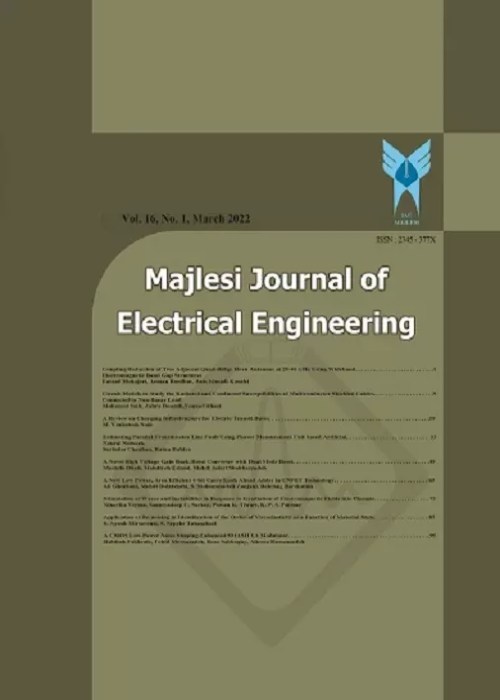فهرست مطالب
Majlesi Journal of Electrical Engineering
Volume:6 Issue: 2, Jun 2012
- تاریخ انتشار: 1391/04/31
- تعداد عناوین: 7
-
Page 1a new configuration for a diode-clamped multi-level inverter based on a multi-winding transformer was proposed and simulated. The most important difference between this proposed DC-AC-AC structure and the basic structure is that; in the proposed structure, the back-to-back connected outputs of a multi-winding transformer supersede the capacitors in the basic structure. The proposed structure provides the equilibrium in the total time of drawing power between the voltage source steps, as a result, decreasing the unbalancing effect. Isolation and capability to produce more output steps are other advantages of the proposed schematic compared with the conventional capacitor based diode-clamped structure. The simulation result shows the ability of this inverter to feed inductive loads.
-
PSO Based Voltage Profile Improvement by Optimizing the Size and Location of DGsPage 5
-
Digital simulation of fault tolerant inverter fed induction motor with a leg swap modulePage 6
-
Page 7This paper presents a predictive strategy to control torque and flux of an Axial Flux Permanent magnet Machine (AFPM). Unlike conventional Direct Torque Control (DTC) for the permanent magnet machine that only six actives voltage vectors of inverter are used to control torque and flux of machine, in Predictive Torque Control (PTC), zero voltage vector is used to control machine, in addition to six active voltage vectors. So the number of voltage vectors to control AFPM increases that leads to faster dynamic torque response and lower ripple of torque and flux. In predictive torque control presented in this paper, the response of torque and flux, compute for all possible switching states of inverter at every sample time according to discrete time model of machine by minimum calculations, and then the switching state that optimum ripple of torque and flux, will be applied in next discrete-time interval. Simulation results, which confirm the good performance of the proposed predictive torque control, are presented.
-
Page 14To make human–computer interaction (HCI) more natural and friendly, it would be beneficial to give computers the ability to recognize situations the same way a human does. Naturally, People use a spontaneous combination of face, body gesture and speech to express their feelings. In this paper we simulate human perception of emotion with emotion related information from facial expression. Facial expression recognition based upon ITMI and QIM which can be seen as an extension to temporal templates. The system was tested on two different databases, the eNterface‘05 and the Cohn-Kanade face database and the recognition accuracy of our systems (71.8 % on Cohn-Kanade and 39.27% on eNterface‘05) compared to the published results in the literature.
-
Page 21This paper describes the investigation and evaluation of low cost depth sensor system for unmanned underwater vehicle (UUV) using pressure sensor. With the growing use of UUV, the purpose of this paper is to investigate and evaluate two types of low cost pressure sensor system for underwater vehicle to prevent buckling or damage, and analyze the accuracy and reliability between two types of pressure sensor systems for underwater vehicle. The system with good performances in-term of accuracy and reliability with low cost will be used as sensor for UUV and to study the effect of three types of condition of water density for testing pressure sensor system such as water tank, lake and swimming pool. The pressure sensors used are barometric pressure sensor since the sensor measure for the absolute pressure and MPX4250AP and MPX5700AP, integrated silicon pressure sensor on-chip signal conditioned, temperature compensated and calibrated which also in absolute configuration. This pressure sensor will be operating automatically when it touches the water after UUV is activated. The result obtained shows that both pressure sensor have the different performances. Also in this paper the different results with different water density will be discussed. Based on the results of the analysis, MPX AP sensor is more suitable to be applied to UUV with low cost budget. For range depth up to 30 meter, MPX 4250 AP more suitable to used and MPX 5700 AP the range depth up to 70 meter.
-
Page 45Minimal stopping distance, guaranteed steering ability and stability are the three most important purposes in Anti-lock Braking System (ABS) realm. The ABS system is a nonlinear, time variant and multivariable system with some uncertainties. Some research work has been carried out on ABS control systems using intricate methods which are expensive to implement. In this paper at the first step the system interference is decreased via decoupling matrix and the ABS is controlled with a robust diagonal controller. In fact, a decentralized control technique is used for our ABS control mechanism. At the second step we exploit a multivariable technique in linear control to attack the problem. This is the Designed Linear Control with Multivariable Technique. The Optimal Eigenstructure Assignment with Genetic Algorithm (GA) method is also applied. Simulation and comparison studies are used to show the effectiveness of the proposed methods.


